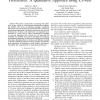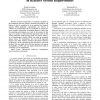RE
2015
Springer
8 years 7 months ago
2015
Springer
—The environment, where a safety critical system (SCS) operates, is an important source from which safety requirements of the SCS can originate. By treating the system under cons...
RE
2015
Springer
8 years 7 months ago
2015
Springer
Abstract—We present a framework for reasoning with preferences in the context of Goal-Oriented Requirements Engineering (GORE). Our choice of preference language, conditional imp...
RE
2015
Springer
8 years 7 months ago
2015
Springer
Abstract—Emerging cyberjustice systems are in need of relevant requirements engineering approaches, for example, to provide citizens with better access to the judicial system. In...
RE
2015
Springer
8 years 7 months ago
2015
Springer
—Whiteboards and paper allow for any kind of notations and are easy to use. Requirements engineers love to use them in creative requirements elicitation and design sessions. Howe...
RE
2015
Springer
8 years 7 months ago
2015
Springer
—We apply an existing formal framework for practical reasoning with arguments and evidence to the Goal-oriented Requirements Language (GRL), which is part of the User Requirement...
RE
2015
Springer
8 years 7 months ago
2015
Springer
— Understanding the stakeholder’s needs, particularly the end-user’s need is important when designing and developing a critical infrastructure like power grid. Smart metering...
RE
2015
Springer
8 years 7 months ago
2015
Springer
System requirements are typically specified on the assumption that the system's operating environment will behave in what is considered to be an expected and nominal manner. W...
RE
2015
Springer
8 years 7 months ago
2015
Springer
Abstract—One of the key challenges in the software engineering lies in requirement engineering. As an important technique for modeling and analyzing requirements, software archit...
RE
2015
Springer
8 years 7 months ago
2015
Springer
—Software systems are characterized by continual change which often occurs concurrently across various artifact types. For example, changes may be initiated at the requirements, ...
RE
2015
Springer
8 years 7 months ago
2015
Springer
—Inconsistency is a major challenge in requirements engineering, commonly perceived as a problem that needs to be eliminated on sight. However, in practice maintaining consistenc...








